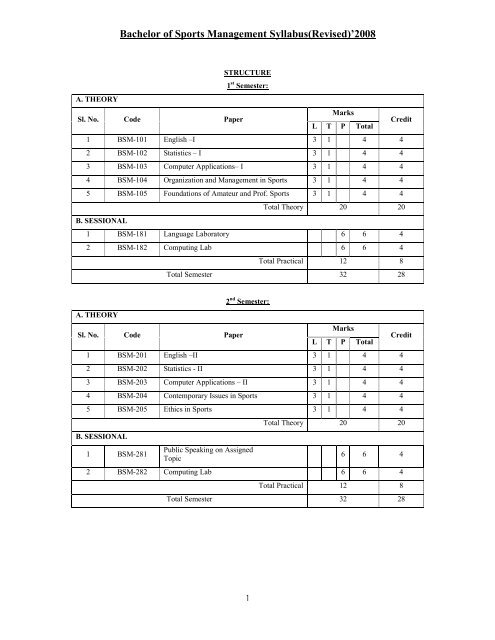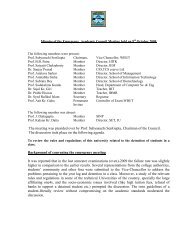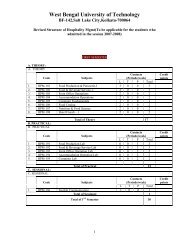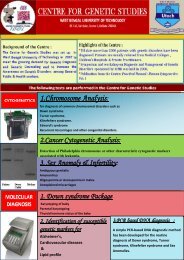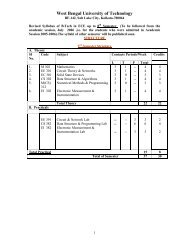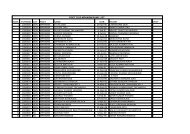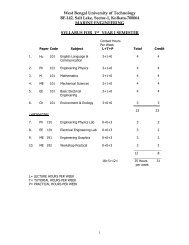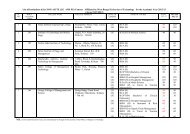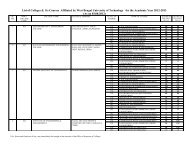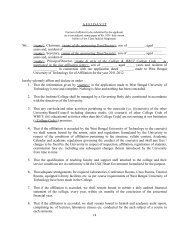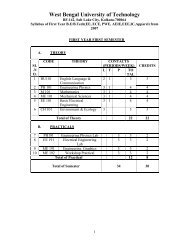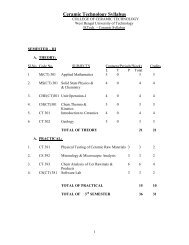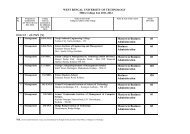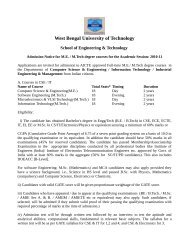Bachelor of Sports Management Syllabus(Revised)'2008 - WBUT
Bachelor of Sports Management Syllabus(Revised)'2008 - WBUT
Bachelor of Sports Management Syllabus(Revised)'2008 - WBUT
You also want an ePaper? Increase the reach of your titles
YUMPU automatically turns print PDFs into web optimized ePapers that Google loves.
<strong>Bachelor</strong> <strong>of</strong> <strong>Sports</strong> <strong>Management</strong> <strong>Syllabus</strong>(<strong>Revised</strong>)’2008<br />
STRUCTURE<br />
1 st Semester:<br />
A. THEORY<br />
Sl. No. Code Paper<br />
Marks<br />
L T P Total<br />
Credit<br />
1 BSM-101 English –I 3 1 4 4<br />
2 BSM-102 Statistics – I 3 1 4 4<br />
3 BSM-103 Computer Applications– I 3 1 4 4<br />
4 BSM-104 Organization and <strong>Management</strong> in <strong>Sports</strong> 3 1 4 4<br />
5 BSM-105 Foundations <strong>of</strong> Amateur and Pr<strong>of</strong>. <strong>Sports</strong> 3 1 4 4<br />
Total Theory 20 20<br />
B. SESSIONAL<br />
1 BSM-181 Language Laboratory 6 6 4<br />
2 BSM-182 Computing Lab 6 6 4<br />
Total Practical 12 8<br />
Total Semester 32 28<br />
A. THEORY<br />
Sl. No. Code Paper<br />
2 nd Semester:<br />
Marks<br />
L T P Total<br />
1 BSM-201 English –II 3 1 4 4<br />
2 BSM-202 Statistics - II 3 1 4 4<br />
3 BSM-203 Computer Applications – II 3 1 4 4<br />
4 BSM-204 Contemporary Issues in <strong>Sports</strong> 3 1 4 4<br />
5 BSM-205 Ethics in <strong>Sports</strong> 3 1 4 4<br />
B. SESSIONAL<br />
1 BSM-281<br />
Public Speaking on Assigned<br />
Topic<br />
Credit<br />
Total Theory 20 20<br />
6 6 4<br />
2 BSM-282 Computing Lab 6 6 4<br />
Total Practical 12 8<br />
Total Semester 32 28<br />
1
<strong>Bachelor</strong> <strong>of</strong> <strong>Sports</strong> <strong>Management</strong> <strong>Syllabus</strong>(<strong>Revised</strong>)’2008<br />
3 rd Semester:<br />
A. THEORY<br />
Sl. No. Code Paper<br />
Marks<br />
L T P Total<br />
Credit<br />
1 BSM-301 Principles <strong>of</strong> <strong>Management</strong> 3 1 4 4<br />
2 BSM-302 Business Communication 3 1 4 4<br />
3 BSM-303 Financial Accounting 3 1 4 4<br />
4 BSM-304 <strong>Sports</strong> Training and Conditioning 3 1 4 4<br />
5 BSM-305 Leadership Principles in <strong>Sports</strong> 3 1 4 4<br />
Total Theory 20 20<br />
B. SESSIONAL<br />
1 BSM-381 Managing <strong>Sports</strong> Events 8 8<br />
Total Sessional 28 28<br />
Total Semester 28 28<br />
4 th Semester:<br />
A. THEORY<br />
Sl. No. Code Paper<br />
Marks<br />
L T P Total<br />
Credit<br />
1 BSM-401 Financial <strong>Management</strong>-I 3 1 4 4<br />
2 BSM-402 Marketing <strong>Management</strong>-I 3 1 4 4<br />
3 BSM-403 Human Resource <strong>Management</strong>-I 3 1 4 4<br />
4 BSM-404<br />
Advertising , Public Relation and<br />
Sponsorship in <strong>Sports</strong><br />
3 1 4 4<br />
5 BSM-405 <strong>Sports</strong> Facilities Planning and <strong>Management</strong> 3 1 4 4<br />
Total Theory 20 20<br />
B. SESSIONAL<br />
1 BSM-481 First Aid and CPR 8 8<br />
Total Sessional 28 28<br />
Total Semester 28 28<br />
2
<strong>Bachelor</strong> <strong>of</strong> <strong>Sports</strong> <strong>Management</strong> <strong>Syllabus</strong>(<strong>Revised</strong>)’2008<br />
5 th Semester:<br />
A. THEORY<br />
Sl. No. Code Paper<br />
Marks<br />
L T P Total<br />
Credit<br />
1 BSM-501 Basics <strong>of</strong> <strong>Sports</strong> Medicine & Nutrition 3 1 4 4<br />
2 BSM-502 <strong>Sports</strong> Marketing 3 1 4 4<br />
3 BSM-503 Managing and Promoting <strong>Sports</strong> Events 3 1 4 4<br />
4 BSM-504 Spectator <strong>Management</strong> 3 1 4 4<br />
5 BSM-505 Funding in <strong>Sports</strong> 3 1 4 4<br />
Total Theory 20 20<br />
B. SESSIONAL<br />
1 BSM-581 Project 4 4<br />
2 BSM-582 Defence <strong>of</strong> Project 4 4<br />
Total Sessional 28 28<br />
Total Semester 28 28<br />
6 th Semester:<br />
A. THEORY<br />
Sl. No. Code Paper<br />
Marks<br />
L T P Total<br />
Credit<br />
1 BSM-601 <strong>Sports</strong> Law and Risk <strong>Management</strong> 3 1 4 4<br />
2 BSM-602 Psychology <strong>of</strong> <strong>Sports</strong> 3 1 4 4<br />
3 BSM-603 Managing <strong>Sports</strong> Organization 3 1 4 4<br />
4 BSM-604 <strong>Sports</strong> Media and Event <strong>Management</strong> 3 1 4 4<br />
5 BSM-605 Administration <strong>of</strong> Games & Leisure Plex 3 1 4 4<br />
Total Theory 20 20<br />
B. SESSIONAL<br />
1 BSM-681 Comprehensive Viva 8 8<br />
Total Sessional 28 28<br />
Total Semester 28 28<br />
3
<strong>Bachelor</strong> <strong>of</strong> <strong>Sports</strong> <strong>Management</strong> <strong>Syllabus</strong>(<strong>Revised</strong>)’2008<br />
1 ST SEMESTER<br />
BSM – 101 : ENGLISH – I<br />
Course Contents<br />
1. Grammatical Focus : Grammatical & Structural aspects covering Partys <strong>of</strong> Speech, Tense, Voice, Clause,<br />
Preposition, Degrees <strong>of</strong> Comparison, Synonyms & Antonyms, etc; Identifying & Analyzing Grammatical Errors<br />
including errors in Spelling & Punctuation.<br />
2. Reading : Vocabulary Building; Comprehension; Interpretation; Summarizing<br />
3. Writing : Letter Writing – Formal, Informal; Accepting & Declining Invitations; Paragraph Writing, Precise<br />
Writing, Essay Writing<br />
4. Speaking : Interactive Communication like Introducing Self, Greetings, Conversations, etc; Pronunciation :<br />
appropriate stress, intonation, clarity<br />
5. Listening : Understanding – Spoken English, Formal English; Exercises<br />
Suggested Reading<br />
1. Leo Jones, Richard Alexander : New International Business English (Communication<br />
Skills in English for Business Purposes), Cambridge University Press.<br />
2. NCERT, Knowing about English – A Book <strong>of</strong> Grammar & Phonology<br />
3. NCERT, Working with English – A Workbook,<br />
4. A.E. Augustine & K.V. Joseph : Macmillan Grammar – A Handbook, Macmillan<br />
5. Krishna Mohan & N.P. Singh : Speaking English Effectively, Macmillan<br />
BSM – 102 : STATISTICS – I<br />
Course Contents<br />
1. Introduction: Statistics as a subject; Functions, Importance and Limitations <strong>of</strong> Statistics; Planning and<br />
Execution <strong>of</strong> a statistical investigation; Census and sample investigation; Descriptive and Inferential statistics.<br />
2. Collection, Editing and Presentation <strong>of</strong> Data: Primary data and secondary data; Methods <strong>of</strong> collection;<br />
Scrutiny <strong>of</strong> data. Presentation <strong>of</strong> data: textual and tabular presentations; Construction <strong>of</strong> a table and the different<br />
components <strong>of</strong> a table. Diagrammatic representation <strong>of</strong> data: Line diagrams, Bar diagrams, Pie charts and<br />
divided-bar diagrams.<br />
3. Frequency Distributions: Attribute and variable; Frequency distribution <strong>of</strong> an attribute; Discrete and<br />
continuous variables; Frequency distributions <strong>of</strong> discrete and continuous variables; Bivariate and Multivariate<br />
Frequency Distributions.<br />
4. Measures <strong>of</strong> Central Tendency: Definition and utility; Characteristics <strong>of</strong> a good average; Different measures<br />
<strong>of</strong> average; Arithmetic Mean; Median; Other positional measures – quartiles, deciles, percentiles; Mode;<br />
Relation between Mean, Median and Mode; Geometric and Harmonic Mean. Choice <strong>of</strong> a suitable measure <strong>of</strong><br />
central tendency.<br />
5. Measures <strong>of</strong> dispersion: Meaning and objective <strong>of</strong> dispersion; Characteristics <strong>of</strong> a good measure <strong>of</strong><br />
dispersion; Different measures <strong>of</strong> dispersion – Range, Quartile deviation, Mean deviation, Mean Absolute<br />
deviation, Standard deviation; Moments, Skewness and Kurtosis:<br />
6. Correlation and Regression: Analysis <strong>of</strong> Bivariate data. Correlation Analysis – Meaning <strong>of</strong> correlation;<br />
Calculation <strong>of</strong> the correlation coefficient from grouped data; Properties <strong>of</strong> the correlation coefficient. Regression<br />
Analysis – Two lines <strong>of</strong> regression; Some important results relating to regression lines; Correlation Coefficient<br />
and the two Regression Coefficients.<br />
4
<strong>Bachelor</strong> <strong>of</strong> <strong>Sports</strong> <strong>Management</strong> <strong>Syllabus</strong>(<strong>Revised</strong>)’2008<br />
Suggested Readings<br />
1. R.I.Levin & D.S. Rubin: Statistics for <strong>Management</strong>: Pearson Education<br />
2. Amir D. Aczel & Jayavel Sounderpandian – Complete Business Statistics: Tata<br />
McGraw- Hill<br />
3. R.S Bhardwaj, Business Statistics, Excel Books<br />
4. P Gupta & M.P. Gupta: Business Statistics: Sultan Chand & Sons<br />
5. G. C. Beri – Statistics for <strong>Management</strong>: Tata McGraw- Hill<br />
6. A.M Goon, M.K Gupta & B, Dasgupta : Basic Statistics : World Press.<br />
7. Hoel & Jessen: Basic Statistics for Business and Economics; John Wiley & Sons, New<br />
York.<br />
8. Anderson, Sweeney and Williams – Statistics for Business and Economics, West<br />
Publishers<br />
BSM – 103 : COMPUTER APPLICATIONS – I<br />
Course Contents<br />
1. Basic Computer Concepts – Different generations <strong>of</strong> computer hardware; Modern taxonomy <strong>of</strong> computers;<br />
Hardware and s<strong>of</strong>tware; Programming languages; Problem solving and algorithms; Basic computer applications;<br />
General idea <strong>of</strong> information and communication technologies; Information system development process.<br />
2. Computer Hardware – Input and Output devices; Memory (or storage) devices; Central Processing Unit. Input<br />
/ Output devices: keyboard, mouse, light pen, barcode readers, scanners, MICR, OCR, voice recognition and<br />
handwriting recognition systems; visual display terminals, printers, plotters etc. Storage devices: Primary<br />
storage – RAM, ROM, EEROM, PROM, EPROM; Secondary storage – direct access devices, serial access<br />
devices: hard disks, floppy disks, magnetic tape, CD-ROM, DVD; Cache memory and Virtual memory. Central<br />
Processing Unit – Control Unit; Arithmetic and Logic Unit; Decoders; Registers; Machine Instructions; Stored<br />
program concept; Program execution: Fetch-Decode-Execute cycle; Arithmetic, logical and shift operations.<br />
3. Computer S<strong>of</strong>tware – Meaning <strong>of</strong> s<strong>of</strong>tware; broad classification <strong>of</strong> s<strong>of</strong>tware; system<br />
s<strong>of</strong>tware and application s<strong>of</strong>tware; utilities. Systems s<strong>of</strong>tware – Operating systems: Basic idea <strong>of</strong> an OS; OS as a<br />
resource manager – memory management, input/output management, secondary storage management, processor<br />
management, program management, network management; Brief introduction to different types <strong>of</strong> operating<br />
systems like DOS, Windows, Unix, Linux etc. Application s<strong>of</strong>tware – System development tools, Utilities,<br />
Application packages, User written programs.<br />
4. Programming languages and Algorithms – The concept <strong>of</strong> programming; pseudocode and<br />
flowcharts; structure <strong>of</strong> programs; program development guidelines; programming languages – machine<br />
language, assembly languages, high-level languages (procedural and object-oriented languages), fourth<br />
generation languages; object code and executable codes;<br />
compilers, translators, assemblers; editing tools such as vi. Algorithms – Basic concept; Some typical algorithms<br />
– Finding the sum <strong>of</strong> a series, solving a quadratic equation, generating Fibonacci sequence, checking whether a<br />
number is prime or not, creating an array <strong>of</strong> numbers and displaying the largest element in the list, sorting a<br />
given set <strong>of</strong> numbers, multiplying together two matrices etc. (The algorithms may be implemented using either<br />
pseudocode or a high level programming language).<br />
5. Computer networks and Internet – Basic concepts <strong>of</strong> computer networks; local area networks and wide area<br />
networks; switches, hubs, routers, idea <strong>of</strong> distributed systems; the Internet and the World Wide Web.<br />
6. Computer Applications: Essential features <strong>of</strong> computer systems and structures required for <strong>of</strong>fice automation,<br />
communications, control systems, data acquisition, interactive multimedia, networking, parallel processing and<br />
neural networks.<br />
Suggested Readings<br />
1. Mano – Computer System Architecture; Pearson Education<br />
2. Tanenbaum – Structured Computer Organization,Pearson Education<br />
3. Martin & Powell – Information Systems: A <strong>Management</strong> Perspective; McGraw-Hill<br />
4. Laudon & Laudon – <strong>Management</strong> Information Systems: Pearson Education<br />
5. Comer: Computer Networks and the Internet: Pearson Education<br />
6. Graham Curtis – Business Information Systems: Addison Wesley.<br />
5
<strong>Bachelor</strong> <strong>of</strong> <strong>Sports</strong> <strong>Management</strong> <strong>Syllabus</strong>(<strong>Revised</strong>)’2008<br />
BSM – 104 : ORGANISATION AND MANAGEMENT IN SPORTS<br />
Course Contents<br />
1. Concept <strong>of</strong> Organisational Behaviour: Meaning <strong>of</strong> O.B., Contributing Disciplines to O.B,<br />
Individual Behaviour – Ability, Learning, Values, Attitudes, Personality, Perceptions.<br />
2. Organisation Structure: Meaning <strong>of</strong> Organisation Structure, Types <strong>of</strong> Organisation Structure, Flat<br />
Organisations, Tall Organisations, Reporting Relationship, Channels <strong>of</strong> Communication, Organisation Structure<br />
as Applied to <strong>Sports</strong> Organizations.<br />
3. Decision Making Process: Individual Decision Making, Rational Decision Making, Decision making Styles,<br />
Creativity in Decision Making, Participative Decision Making, Group decision Making.<br />
4. Leadership : What is Leadership, Trait Theories <strong>of</strong> Leadership, Leadership Styles, How Leaders influence<br />
People, Fiedler Model, Trust and Leadership. Improving Leadership Effectiveness.<br />
5. Group and Teams : Meaning <strong>of</strong> a Group, Group Dynamics, Group Cohesiveness, Types <strong>of</strong><br />
Groups, Task Groups, Work Teams, Nature <strong>of</strong> Teams, Team Building, Group/Teams<br />
Effectiveness, How to Make Teams More Effective.<br />
6. Conflict: Definition <strong>of</strong> Conflict, Stages in Conflict Process , Functional Conflict, Dysfunctional Conflict,<br />
Managing Conflict, Negotiation.<br />
7. Managing For High Performance: High Performance Work Practices, Goal Setting, Performance<br />
<strong>Management</strong> Techniques Associated with Goal Setting, Application <strong>of</strong> Goal Setting to Organisational<br />
Performance.<br />
8. <strong>Management</strong> <strong>of</strong> <strong>Sports</strong>: <strong>Management</strong> <strong>of</strong> Sporting and Recreation Organisation, Decision process and<br />
Leadership in <strong>Sports</strong> <strong>Management</strong>, Delivery <strong>of</strong> Recreation Services, Impact <strong>of</strong><br />
Organisational Process on Individual.<br />
Suggested Readings<br />
1. Fred Luthans - Organizational Behaviour : McGraw Hill Internatyional<br />
2. S P Robins - Organizational Behaviour : Prentrice Hall India Ltd.<br />
3. Ghanekar - Organizational Behaviour Concept & Cases : EPH<br />
BSM – 105 : FOUNDATIONS OF AMATEUR AND PROFESSIONAL SPORTS<br />
Course Contents<br />
1. Regulations <strong>of</strong> Amateur <strong>Sports</strong> : Govt. Regulations relating to Amateur <strong>Sports</strong>, Role <strong>of</strong> Amateur Athletic<br />
Associations in promotion <strong>of</strong> <strong>Sports</strong>, Analysing the legal ramification <strong>of</strong> Actions <strong>of</strong> Amateur Athletic<br />
Associations and their Athletes, Regulation <strong>of</strong> Amateur Athletics, Bodies Empowered to Control Amateur<br />
<strong>Sports</strong>.<br />
2. Constitutional Issues : Constitutional Provisions for Development and Promotion <strong>of</strong> <strong>Sports</strong>, 3. Tort Liability:<br />
Meaning <strong>of</strong> Tort Liability, Implications for Athletes, Impact on other Amateur <strong>Sports</strong>,<br />
4. Pr<strong>of</strong>essional Team <strong>Sports</strong>: <strong>Sports</strong> based on Team Performance – Football, Volley Ball, Basket Ball, Cricket,<br />
Hockey, Rowing. Guiding Principles for Conduct <strong>of</strong> Team <strong>Sports</strong>, Organisation <strong>of</strong> Tournaments, Leagues,<br />
Knock-out.<br />
5. Individual <strong>Sports</strong>: An Overview <strong>of</strong> Individual <strong>Sports</strong>, Emerging Trend, Future Potential, Studies related to<br />
Governance <strong>of</strong> Individual <strong>Sports</strong> like Golf, Tennis, Badminton, Auto Racing, Track Race.<br />
BSM – 181 : Language Laboratory<br />
Public Speaking in English: Presentations<br />
People speak in public for many reasons. One <strong>of</strong> the most common forms <strong>of</strong> public speaking is the<br />
'Presentation'. In a presentation, you 'present' or introduce something (a product, an idea, financial results, a<br />
6
<strong>Bachelor</strong> <strong>of</strong> <strong>Sports</strong> <strong>Management</strong> <strong>Syllabus</strong>(<strong>Revised</strong>)’2008<br />
project etc) to your audience. You give a presentation because you want to 'communicate' something. Generally,<br />
you want to do one <strong>of</strong> four things. You want:<br />
o to inform<br />
o to train<br />
o to persuade<br />
o to sell<br />
A presentation is one <strong>of</strong> the best ways <strong>of</strong> communicating your message. And because English is so widely used<br />
in international business, knowledge <strong>of</strong> the vocabulary and techniques used in an English language presentation<br />
is very useful. This article will give you 7 <strong>of</strong> the most important areas to consider when giving any presentation.<br />
1 Preparation<br />
Prepare! Prepare! Prepare! Good preparation is essential for any presentation. With good preparation and<br />
planning you will be fully confident. Your audience will feel your confidence. And so your audience will be<br />
confident in you. This will give you control. With control, you will be 'in charge' and your audience will listen<br />
positively to your message.<br />
2 Structure<br />
A good presentation has a clear structure, like a good book or film. A good presentation has:<br />
o a beginning (introduction & preview)<br />
o a middle (main message)<br />
o an end (review & conclusion)<br />
3 Equipment<br />
You may have any <strong>of</strong> the following pieces <strong>of</strong> equipment at your disposal:<br />
o whiteboard<br />
o flipchart<br />
o overhead projector<br />
o 35mm slide projector<br />
4 Signposting<br />
When you read a book, you know where you are. You know the title <strong>of</strong> the book, the subject, the chapter, the<br />
end <strong>of</strong> one chapter and beginning <strong>of</strong> another, the section and even the page number. But when you give a<br />
presentation, your audience does not know where they are - unless you TELL them! You can use special<br />
language called 'signalling' or 'signposting' that<br />
helps your audience know where they are. Here are a few examples:<br />
o Let's begin by...<br />
o That's all I have to say about...<br />
o Now we'll move on to...<br />
o Let's consider this in more detail...<br />
o I'd like to deal with this question later, if I may...<br />
o I'd like now to recap...<br />
o To start with...later...to finish up...<br />
5 Audience Rapport<br />
You need a warm and friendly relationship with your audience. How do you achieve this Well, enthusiasm is<br />
contagious. If you are enthusiastic, your audience will be enthusiastic too. Try to make eye contact with each<br />
member <strong>of</strong> your audience. Each person should feel that you are speaking to him or her personally.<br />
6 Body Language<br />
What you do NOT say can be more important than what you say. Your BODY is speaking to your audience<br />
even before you open your mouth. Your clothes, your walk, your glasses, your haircut, your expression: it is<br />
from these that your listeners form their first impression as you enter the room. This article is taken from<br />
Presentations & Public Speaking in English<br />
http://www.englishclub.com/speaking/presentations.htm<br />
BSM – 182 : Computing Lab<br />
Exercises should include but not limited to:<br />
1. DOS System commands and Editors (Preliminaries)<br />
2. UNIX system commands and vi (Preliminaries)<br />
3. Simple Programs: simple and compound interest. To check whether a given number is a palindrome or not,<br />
evaluate summation series, factorial <strong>of</strong> a number, generate Pascal’s triangle, find roots <strong>of</strong> a quadratic equation<br />
4. Programs to demonstrate control structure: text processing, use <strong>of</strong> break and continue, etc.<br />
5. Programs involving functions and recursion<br />
6. Programs involving the use <strong>of</strong> arrays with subscripts and pointers<br />
7. Programs using structures and files.<br />
7
<strong>Bachelor</strong> <strong>of</strong> <strong>Sports</strong> <strong>Management</strong> <strong>Syllabus</strong>(<strong>Revised</strong>)’2008<br />
2 ND SEMESTER<br />
BSM – 201 : English – II<br />
Course Contents<br />
1. Grammar – Expressing in Style : Words <strong>of</strong>ten Confused; One-word substitution; Phrases; Idioms.<br />
2. Advanced Reading : Understanding business-related correspondences; Comprehension <strong>of</strong> factual material;<br />
Interpreting Visual Information : Tables, Graphs, Charts; Speed Reading<br />
3. Effective Writing : Business Correspondences (Letter, Fax, e-mail) for : Making Enquiries, Placing Orders,<br />
Asking & Giving Information, Registering Complaints, Handling Complaints; Drafting notices; Drafting<br />
Advertisements; Job Applications<br />
4. Speaking : Business Etiquettes; Impromptu Speech; Debate; Role Play; Presentations<br />
5. Listening : Business-related Conversations; Exercises<br />
Suggested Readings :<br />
1. A. Ashley : A Handbook <strong>of</strong> Commercial Correspondence, OUP<br />
2. M. Monipatty: The Craft <strong>of</strong> Business Letter Writing, Tata McGraw Hill<br />
3. N. Gupta (Ed.) : English for All, Macmillan<br />
4. K. Mohan & M. Banerjee : Developing Communication Skills, Macmillan<br />
5. M. Osborn & S. Osborn : Public Speaking, AITBS Publishers<br />
6. M.A. Rizvi : Effective Technical Communication, Tata McGraw-Hill<br />
BSM – 202 : Statistics – II<br />
Course Contents<br />
1. Theory <strong>of</strong> Probability: Probability as a concept; Basic probability rules; Tree diagrams; Conditional<br />
probability; Mutually exclusive events and independent events; Bayes’ Theorem or Inverse probability rule.<br />
2. Probability distribution <strong>of</strong> a Random Variable: Discrete and Continuous random variables;<br />
Expectation value; Mean and Variance <strong>of</strong> a Random Variable; Theorems on expectation; Marginal and joint<br />
probability distributions.<br />
3. Theoretical Probability Distributions: Probability mass function and density function;<br />
Discrete distributions – The Binomial distribution and its properties; The Poisson distribution and its properties;<br />
Fitting a Binomial or Poison distribution to an observed distribution. Continuous distributions –Uniform,<br />
Exponential and Normal distributions; Normal approximation to Binomial and Poisson distributions; Fitting a<br />
normal curve to an observed distribution.<br />
4. Sampling and Sampling Distributions: Sampling versus complete enumeration;<br />
Random and nonrandom sampling; Different types <strong>of</strong> random sampling; Sampling distributions – Standard<br />
error; sampling distribution <strong>of</strong> the sample mean and the sample proportion. Sampling from normal and nonnormal<br />
populations; The Central Limit Theorem.<br />
Four Basic Distributions: Standard normal distribution; Chi-square distribution; tdistribution;<br />
F-distribution<br />
5. Chi-Square and Analysis <strong>of</strong> Variance: Chi-Square as a test <strong>of</strong> independence and<br />
as a test <strong>of</strong> goodness <strong>of</strong> fit. Analysis <strong>of</strong> Variance: Calculating the variance among the samples and within the<br />
samples.<br />
Suggested Readings<br />
1. R.I.Levin & D.S. Rubin: Statistics for <strong>Management</strong>: Prentice Hall <strong>of</strong> India<br />
2. Amir D. Aczel & Jayavel Sounderpandian – Complete Business Statistics: Tata McGraw- Hill<br />
3. Freund – Mathematical Statistics<br />
4. G. C. Beri – Business Statistics, Second Edition: Tata McGraw- Hill<br />
5. A.M Goon, M.K Gupta & B, Dasgupta : Basic Statistics : World Press.<br />
6. Hoel & Jessen: Basic Statistics for Business and Economics; John Wiley & Sons, New York.<br />
7. Anderson, Sweeney and Williams – Statistics for Business and Economics, West Publishers<br />
8
<strong>Bachelor</strong> <strong>of</strong> <strong>Sports</strong> <strong>Management</strong> <strong>Syllabus</strong>(<strong>Revised</strong>)’2008<br />
BSM – 203 : Computer Applications – II<br />
Course Contents<br />
1. Word processing s<strong>of</strong>tware: Micros<strong>of</strong>t Word – The different functionalities in the Micros<strong>of</strong>t Word s<strong>of</strong>tware;<br />
Creation <strong>of</strong> a new document; Editing an existing document; Saving and printing a file; Use <strong>of</strong> the different tools;<br />
Handling tables in MS Word.<br />
2. Spreadsheet s<strong>of</strong>tware: Micros<strong>of</strong>t Excel – Creating a new spreadsheet document and editing an existing<br />
document; Using the different tools available in MS Excel. Performing mathematical calculations using MS<br />
Excel including various types <strong>of</strong> statistical measures.<br />
Reference Operators, Functions, Typing a Function. Creating a column chart; Changing the size and position <strong>of</strong><br />
a chart Saving a file in Micros<strong>of</strong>t Excel; Closing a Micros<strong>of</strong>t Excel worksheet.<br />
3. Database <strong>Management</strong> System: Data Modeling; The Relational Model; Database design and Query<br />
Languages; File organization, indexing and hashing; Transaction Processing and Concurrency Control;<br />
Database backup and recovery. DBMS S<strong>of</strong>tware: Micros<strong>of</strong>t Access - Creating New and Opening Existing<br />
Databases, Creating a database using a wizard and without using a wizard; Tables – Introduction and advanced<br />
features. Relationships - How to link multiple tables together; Forms and Reports; Creating Mail Merge Labels<br />
using a Wizard.<br />
4. Presentation S<strong>of</strong>tware: Micros<strong>of</strong>t PowerPoint – The different functionalities <strong>of</strong> Micros<strong>of</strong>t PowerPoint.<br />
Creating a PowerPoint presentation; Creating and inserting a new slide; Creating a title slide; Applying a design<br />
template; Creating a hierarchy, Using a two-column text; Slide Sorter view; Running the slide show; Printing<br />
the slides.<br />
5. Project <strong>Management</strong> S<strong>of</strong>tware: MS Project – Getting started with a project; Developing a<br />
timeline ; Displaying and Printing the schedule; Assigning resources and costs to the tasks and resolving<br />
resource allocation problems; Finalizing and Publishing the Project Plan; Managing and Tracking the Project;<br />
Working with multiple projects, using MS Project in workgroups.<br />
Suggested Readings<br />
1. Introduction to Computers with MS-Office, Leon, TMH<br />
2. A First Course in Computers 2003, Saxena, VIKAS<br />
3. Windows ’98 in easy steps, Harshad Kotecha, Wiley Dreamtech<br />
4. Office 2000 in easy steps, Stephen Copestake, Wiley Dreamtech<br />
5. Windows and MS Office 2000, Krishnan, SCITECH<br />
6. Micros<strong>of</strong>t Project 2000 in 24 hours, Tim Pyron, Techmedia<br />
7. An Introduction to Database Systems - C.J. Date, Pearson Education<br />
BSM – 204 : CONTEMPORARY ISSUES IN SPORTS<br />
Course Contents<br />
1. History <strong>of</strong> Modern <strong>Sports</strong> and other Forms <strong>of</strong> Organized Physical Activity: A<br />
Historical Overview <strong>of</strong> <strong>Sports</strong>, Evolutionary Processes <strong>of</strong> Modern <strong>Sports</strong>, Relation<br />
between Physical Education and <strong>Sports</strong>, Exercise Physiology<br />
2. Physical Education And <strong>Sports</strong> : History and Principles <strong>of</strong> Physical Education, Organization, Administration<br />
and Methods in Physical Education, Elements <strong>of</strong> Statistics for Physical Education. Supervision and Curriculum<br />
Design In Physical Education.<br />
3. Role <strong>of</strong> Government in Promotion <strong>of</strong> <strong>Sports</strong> : Role <strong>of</strong> the Ministry <strong>of</strong> Human<br />
Resource Development in Development <strong>of</strong> <strong>Sports</strong> and Physical Education, various<br />
Boards and Statutory Bodies established by Govt. for control and promotion <strong>of</strong> <strong>Sports</strong>,<br />
their roles and functions, importance and contributions.<br />
4. Roles and Functions <strong>of</strong> National/International <strong>Sports</strong> Organizations: Roles <strong>of</strong> IFA,<br />
FIFA, BCCI, ICC, CAB, <strong>Sports</strong> Authority <strong>of</strong> India (SAI), National Hockey Association,<br />
Bengal Volley Ball Association, Bengal Tennis Association , their Functions and<br />
9
<strong>Bachelor</strong> <strong>of</strong> <strong>Sports</strong> <strong>Management</strong> <strong>Syllabus</strong>(<strong>Revised</strong>)’2008<br />
Importance in the Promotion and <strong>Management</strong> <strong>of</strong> <strong>Sports</strong> .<br />
5. Social, Cultural and Political Environment <strong>of</strong> <strong>Sports</strong> Organizations: Role <strong>of</strong> <strong>Sports</strong><br />
In Society, issues that <strong>Sports</strong> Administrators face on day to day basis in the contemporary world, Drug abuse<br />
and gratuitous violence,<br />
BSM – 205 : ETHICS IN SPORTS<br />
Course Contents<br />
1. VALUES- Importance, Sources <strong>of</strong> Value System, Types, Loyalty and Ethical Behaviour.<br />
2. ETHICS IN SPORTS– Nature, Characteristics and Needs, Ethical practices in the field <strong>of</strong> <strong>Sports</strong>, <strong>Sports</strong> Code<br />
<strong>of</strong> Conduct.<br />
3. INDIAN VALUES AND ETHICS- Respect for elders, Hierarchy and Status, non- violence and tolerance,<br />
cooperation. Rights and Duties. Holistic relation between Man, Attitudes, Beliefs.<br />
4. ETHICAL VALUE SYSTEM- Distributive Justice, Individual freedom <strong>of</strong> Choice, Pr<strong>of</strong>essional Codes. Their<br />
application in the field <strong>of</strong> sports.<br />
5. SPORTS AS A PROFESSION– Conflict between organization demand, Individual needs and pr<strong>of</strong>essional<br />
ideal, Conflicts the <strong>Sports</strong> Managers face.<br />
6. SOCIAL AND ETHICAL responsibilities <strong>of</strong> different <strong>Sports</strong> Association, Clubs,<br />
Manager, Coach and <strong>Sports</strong> Persons.<br />
7. MORALE OF SPORTSMEN- Role <strong>of</strong> Organizations / Association and <strong>Sports</strong> Manager in the area.<br />
BSM – 301 : Principles <strong>of</strong> <strong>Management</strong><br />
3 RD SEMESTER<br />
Course Contents<br />
1. Introduction : Concept, process and significance <strong>of</strong> management; Managerial roles; An overview <strong>of</strong><br />
functional areas <strong>of</strong> management; Development <strong>of</strong> management thought; Classical and neo-classical systems;<br />
Contingency approaches<br />
2. Planning : Concept, process and types. Decision making – concept and process; <strong>Management</strong> by objectives;<br />
Corporate planning; Environment analysis; Strategy formulation.<br />
3. Organizing : Concept, nature, process and significance; Authority and responsibility relationships;<br />
Centralization and decentralization; Departmentation; Organization structure – forms and contingency factors.<br />
4. Directing : Motivation – Concept & Theories – (Maslow, Alderfer, Herzberg, MClelland, Porter & Lawler,<br />
Vroom); Financial and non-financial iincentatives <strong>of</strong> Motivation,<br />
Leadership – Leadership Theories, Leadership styles. Communication – Type, process and barriers.<br />
5. Controlling : Concept and process; Effective control system; Techniques <strong>of</strong> control.<br />
6. <strong>Management</strong> <strong>of</strong> Change : Concept, nature and process <strong>of</strong> planned change; Resistance to change; <strong>Management</strong><br />
in a changing environment.<br />
Suggested Readings<br />
1. Weihrich and Koontz, et al : Essentials <strong>of</strong> <strong>Management</strong>; Tata McGraw Hill<br />
2. Stoner J and Freeman RE : <strong>Management</strong>; Prentice-Hall<br />
3. Daft, RL : <strong>Management</strong>, Thomson<br />
4. V.S.P Rao & Hari Krishna : <strong>Management</strong>-Text & Cases,Excel Books<br />
10
<strong>Bachelor</strong> <strong>of</strong> <strong>Sports</strong> <strong>Management</strong> <strong>Syllabus</strong>(<strong>Revised</strong>)’2008<br />
5. ramaswami T; Principles <strong>of</strong> Mgmt., Himalaya Publishing<br />
5. Chandan, JS : <strong>Management</strong> – Concepts and Strategies, Vikas Publishing<br />
6. Robbins, SP : <strong>Management</strong>, Prentice Hall<br />
BSM – 302 : Business Communication<br />
Course Contents<br />
1. Introduction Business Communication : Basic forms <strong>of</strong> communicating; Communication models and<br />
processes; Effective communication; Theories <strong>of</strong> communication; Audience Analysis.<br />
2. Self-Development and Communication : Development <strong>of</strong> positive personal attitudes; SWOT analysis; Vote’s<br />
model <strong>of</strong> interdependence; Whole communication.<br />
3. Corporate Communication : Formal and informal communication networks; Grapevine;<br />
Miscommunication (Barriers); Improving communication. Practices in business communication; Group<br />
discussions; Mock interviews; Seminars; Effective listening exercises; Individual and group presentations and<br />
reports writing. Principles <strong>of</strong> Effective<br />
Communication.<br />
4. Writing Skills : Planning business messages; Rewriting and edition; The first draft; Reconstructing the final<br />
draft; Business letters and memo formats Appearance request letters; Good news and bad news letters;<br />
Persuasive letters; Sales letters; Collection letters; Office memorandum.<br />
5. Report Writing : Introduction to a proposal, short report and formal report, report preparation. Oral<br />
Presentation : Principles <strong>of</strong> oral presentation, factors affecting presentation, sales presentation, training<br />
presentation, conducting surveys, speeches to motivate, effective presentations skills.<br />
6. Non-Verbal Communication : Body languages : meanings<br />
7. Effective Listening : Principles <strong>of</strong> effective listening; Factors affecting listening exercises.<br />
8. Modern Forms <strong>of</strong> Communicating : Fax; E-mail; Video conferencing; etc.<br />
Suggested Readings<br />
1. Monipally: Business Communication , Tata McGraw Hill<br />
2. Ronald E. Dulek and John S. Fielder : Principles <strong>of</strong> Business Communication; Macmillan<br />
3. Madhukar : Business Communications; Vikas Publishing House<br />
4. Rai & Rai: Business Communication, Himalaya Publishing<br />
5. Kaul : Business Communication; Prentice Hall<br />
6. Senguin J : Business Communication; Allied Publishers<br />
7. Robinson, Netrakanti and shintre : Communicative Competence in Business English; Orient Longman<br />
BSM – 303 : Financial Accounting<br />
Course Contents<br />
1. Meaning and Scope <strong>of</strong> Accounting : Need, development and definition <strong>of</strong> accounting.<br />
2. Accounting Principles : GAAP; Accounting as MIS<br />
3. Accounting Transactions : Accounting Cycle; Journal; Rules <strong>of</strong> debit and credit; Compound journal entry;<br />
Opening entry; Relationship between journal and ledger; Rules regarding posting; Trial Balance; Sub division <strong>of</strong><br />
journal.<br />
4. Capital and Revenue : Classification <strong>of</strong> Income; Classification <strong>of</strong> expenditure; Classification <strong>of</strong> receipts.<br />
Accounting concept <strong>of</strong> income; Accounting concepts and income measurement; Expired cost and income<br />
measurement. Final accounts; Manufacturing account; Trading account; Pr<strong>of</strong>it and Loss Account; Balance<br />
Sheet; Adjustment entries.<br />
Rectification <strong>of</strong> errors: Classification, Location and Rectification Suspense Account; Effect on Pr<strong>of</strong>it.<br />
11
<strong>Bachelor</strong> <strong>of</strong> <strong>Sports</strong> <strong>Management</strong> <strong>Syllabus</strong>(<strong>Revised</strong>)’2008<br />
5. Depreciation Provisions and Reserves : Concept <strong>of</strong> depreciation; Causes <strong>of</strong> depreciation; depletion,<br />
amortization and dilapidation; Depreciation accounting; Methods <strong>of</strong> recording depreciation; Methods<br />
forproviding depreciation; Depreciation <strong>of</strong> different assets; Depreciation <strong>of</strong> replacement cost; Depreciation<br />
policy as per Accounting Standard, Provisions and reserves.<br />
Suggested Readings<br />
1. Gupta, RL and Radhaswamy, M : Financial Accounting ; Sultan Chand and Sons<br />
2. Ashoke Banerjee: Financial Accounting,Excel Books<br />
3. Maheshwari:Introduction to Accounting,Vikas Publishing<br />
4. Monga JR, Ahuja Girish and Sehgal Ashok : Financial Accounting; Mayur Paper Back<br />
5. Shukla, MC, Grewal TS, and Gupta, SC : Advanced Accounts; S. Chand & Co<br />
6. Compendium <strong>of</strong> Statement and Standards <strong>of</strong> Accounting : The Institute <strong>of</strong> Chartered<br />
Accountants <strong>of</strong> India.<br />
7. Agarwala, AN, Agarwala KN: Higher Sciences <strong>of</strong> Accountancy : Kitab Mahal<br />
8. Anthony, RN and Reece, JS : Accounting Principles; Richard Inwin Inc<br />
9. Ramchandran & Kakani : Financial Accounting for Managers; Tata McGraw-Hill<br />
BSM – 304 : SPORTS TRAINING AND CONDITIONING<br />
Course Contents<br />
UNIT – 1<br />
1. INTRODUCTION TO SPORTS TRAINING<br />
1.1 Meaning and definition <strong>of</strong> <strong>Sports</strong> Training.<br />
1.2 Aims and Tasks <strong>of</strong> <strong>Sports</strong> Training.<br />
1.3 Characteristics <strong>of</strong> <strong>Sports</strong> Training.<br />
1.4 Principles <strong>of</strong> <strong>Sports</strong> Training.<br />
1.5 Training Means.<br />
1.6 Training Methods.<br />
UNIT - II<br />
1. TRAINING LOAD<br />
1.1 Meaning and definition <strong>of</strong> Load.<br />
1.2 Components <strong>of</strong> Load.<br />
1.3 Measurement <strong>of</strong> Load.<br />
1.4 Over Load : Meaning and Definition, Causes, Symptoms and Tackling <strong>of</strong> Over Load.<br />
UNIT - III<br />
1. CONDITIONAL ABILITIES<br />
1.1 STRENGTH : Meaning, Forms <strong>of</strong> Strength, Factors determining Strength, Training Methods for Strength<br />
Improvement, General guidelines for Strength Training.<br />
1.2 SPEED : Meaning, Forms <strong>of</strong> Speed, Factors determining Speed. Training Methods for Speed Improvement.<br />
1.3 ENDURANCE : Meaning, Forms <strong>of</strong> Endurance, Factors determining Endurance. Training Methods for<br />
Endurance Improvement.<br />
UNIT – IV<br />
1. MOTOR ABILITIES<br />
1.1 FLEXIBILITY : Meaning, Forms <strong>of</strong> Flexibility, Factors determining Flexibility. Training Methods for<br />
Flexibility Improvement.<br />
1.2 COORDINATIVE ABILITIES : Meaning, Forms <strong>of</strong> Coordinative Abilities, Factors determining<br />
Coordinative Abilities, Training Methods for Improvement <strong>of</strong> Coordinative Abilities.<br />
UNIT – V<br />
1. TECHNICAL TRAINING, TACTICAL TRAINING, PERIODISATION, PLANNING AND<br />
COMPETITIONS<br />
1.1 TECHNICAL TRAINING : Meaning, Tasks <strong>of</strong> Technique, Principles <strong>of</strong> Technical Preparation, Training for<br />
Technique.<br />
1.2 TACTICAL TRAINING : Meaning, Tasks <strong>of</strong> Tactics, Principles <strong>of</strong> Tactical Preparation, Training for<br />
Tactics.<br />
12
<strong>Bachelor</strong> <strong>of</strong> <strong>Sports</strong> <strong>Management</strong> <strong>Syllabus</strong>(<strong>Revised</strong>)’2008<br />
1.3 PERIODISATION : Meaning and types <strong>of</strong> Periodisation, Contents <strong>of</strong> training for different period.<br />
1.4 PLANNING : Meaning, Principles <strong>of</strong> Planning, Types <strong>of</strong> Training Plans.<br />
1.5 COMPETITIONS : Importance <strong>of</strong> Competition, Preparation for Competitions.<br />
Suggested Readings<br />
1. Cratty, B. Perceptual And Motor Development In Infants And Children, Prentice Hall , 1989.<br />
2. Dick. F. W. <strong>Sports</strong> Training Principles, Lepus, London, 1990.<br />
3. Jenson, C. R. Fisher, A.G. Scientific Basis <strong>of</strong> Athletic Conditioning, Lea And Febiger, Philadelphia, 1992.<br />
4. Matveyew. L. P. Fundamentals <strong>of</strong> <strong>Sports</strong> Training, Mir Publishers, Moscow, 1991.<br />
5. Willmore. J. H. Athletic Training And Physical Fitness, Allynand Bacon, Inc. Sydney, 1987.<br />
BSM – 305 : LEADERSHIP PRINCIPLES IN SPORTS<br />
Course Contents<br />
1. Leadership :- Meaning, <strong>Management</strong> and Leadership in the past and 21st century,<br />
Formal and Informal Leadership.<br />
2. Studies in Leadership :- Ohio State Leadership studies, Trait theories <strong>of</strong> leadership,<br />
Contingency theory, Charismatic Leadership theories, Transactional and Transformational leadership.<br />
3. Issues in Leadership :- Different Leadership styles, Authentic leadership, Trust and Leadership – a relevant<br />
issue in sports, Global Leadership in sports across culture.<br />
4. Leadership in Sporting World in the 21st Century :- National and International <strong>Sports</strong> Organisations - CAB,<br />
IFA, AIFF, BCCI, FIFA, ICC, IOA, BTTA.<br />
5. Case Study on Successful Leadership from Sporting World and Presentation.<br />
6. Role and Activities <strong>of</strong> Successful Leaders in <strong>Sports</strong> <strong>Management</strong> Organizations<br />
BSM – 401 : Financial <strong>Management</strong> – I<br />
4 TH SEMESTER<br />
Course Contents<br />
1. Financial <strong>Management</strong> : Financial goals; Pr<strong>of</strong>it vs wealth maximization; Financial functions – investment,<br />
financing, and dividend decisions; Financial planning.<br />
2. Capital Budgeting : Nature <strong>of</strong> investment decisions, investment evaluation criteria, payback period,<br />
accounting rate <strong>of</strong> return, net present value, internal rate <strong>of</strong> return, pr<strong>of</strong>itability index; NPV and IRR<br />
comparison.<br />
3. Cost <strong>of</strong> Capital : Significance <strong>of</strong> cost <strong>of</strong> capital; Calculating cost <strong>of</strong> debt; Preference shares, equity capital,<br />
and retained earnings; Combined (weighted) cost <strong>of</strong> capital.<br />
4. Operating and Financial Leverage : Measure; Effects on pr<strong>of</strong>it, analyzing alternate financial plans, combined<br />
financial and operating leverage.<br />
5. Capital Structure : Theories and determinants.<br />
6. Dividend Policies : Issues in dividend policies; Walter’s model; M.M. Hypothesis, forms <strong>of</strong> dividends and<br />
stability in dividends, determinants.<br />
7. <strong>Management</strong> <strong>of</strong> Working Capital : Nature <strong>of</strong> working capital, significance <strong>of</strong> working capital, operating cycle<br />
and factors deterining <strong>of</strong> working capital requirements; <strong>Management</strong> <strong>of</strong> working capital – cash, receivables, and<br />
inventories.<br />
Suggested Readings<br />
13
<strong>Bachelor</strong> <strong>of</strong> <strong>Sports</strong> <strong>Management</strong> <strong>Syllabus</strong>(<strong>Revised</strong>)’2008<br />
1. S.Bhatt: Financial <strong>Management</strong>,Excel Books<br />
2. Van Horne, J.C. : Fundamentals <strong>of</strong> Financial <strong>Management</strong>; Prentice Hall <strong>of</strong> India.<br />
3. Khan M.Y. and Jain P.K. : Financial <strong>Management</strong> - Text and Problems; Tata McGraw Hill.<br />
4. Prasanna Chandra : Financial <strong>Management</strong> - Theory and Practice; Tata McGraw Hill.<br />
5. Pandey I.M. : Financial <strong>Management</strong> : Vikas Publishing House.<br />
6. Saha, Tapas Ranjan : Basic Financial <strong>Management</strong>, World Press<br />
BSM – 402 : Marketing <strong>Management</strong> I<br />
Course Contents<br />
1. Introduction : Nature and scope <strong>of</strong> marketing; Importance <strong>of</strong> marketing as a business function and in the<br />
economy; Marketing concepts – traditional and modern; Selling vs. marketing; Marketing mix; Marketing<br />
environment.<br />
2. Consumer Behaviour and Market Segmentation : Nature, scope and significance <strong>of</strong> consumer behaviour;<br />
Market segmentation – concepts and importance; Bases for market segmentation.<br />
3. Product : Concept <strong>of</strong> product, consumer, and industrial goods; Product planning and development; Packaging<br />
– role and functions; Brand name and tade mark; After sales service; Product life cycle concept.<br />
4. Price : Importance <strong>of</strong> price in the marketing mix; Factors affecting price <strong>of</strong> a product/service; Discounts and<br />
rebates.<br />
5. Distributions Channels and Physical Distribution: Distribution channels – concept and role; Types <strong>of</strong><br />
distribution channels; Factors affecting choice <strong>of</strong> a distribution channel; Retailer and wholesaler; Physical<br />
distribution <strong>of</strong> goods; Transportation; Warehousing; Inventory control; Order processing.<br />
6. Promotion : Methods <strong>of</strong> promotion; Optimum promotion mix; Advertising media – their relative merits and<br />
limitations; Characteristics <strong>of</strong> an effective advertisement; Personal selling; Selling as a career; Classification <strong>of</strong><br />
a successful sales person; Functions <strong>of</strong> salesman.<br />
Suggested Readings<br />
1. Kotlar Philip and Armstrong Gary, Principles <strong>of</strong> Marketing; Pearson Education<br />
2. Arun Kumar: Marketing <strong>Management</strong>,Vikas<br />
3. Saxena, Rajan : Marketing <strong>Management</strong>, Tata McGraw Hill<br />
4. Gandhi, J.C. : Marketing, Tata McGraw Hill<br />
5. Tapan Panda: Marketing <strong>Management</strong>,Excel Books<br />
6. Ramaswamy, V.S. and S. Namakumari : Marketing <strong>Management</strong>, Macmillian.<br />
6. B. Ghosh : Fundamentals <strong>of</strong> Marketing <strong>Management</strong>, Books & Allied<br />
BSM – 403 : Human Resource <strong>Management</strong> – I<br />
Course Contents<br />
1. Human Resource <strong>Management</strong> – Overview : Scope & Coverage <strong>of</strong> HRM, Development <strong>of</strong> HR Functions,<br />
Structure and Function <strong>of</strong> HR Manager, Role <strong>of</strong> Line Managers in Managing Human Resources.<br />
2. Human Resource Planning : Need for HR Planning Assessment <strong>of</strong> available HR in the Organization, Work<br />
load Analysis, Manning Norms, Demand Analysis <strong>of</strong> Future Requirement <strong>of</strong> HR, HR Policy.<br />
3. Employment Administration : Recruitment & Selection <strong>of</strong> HR – Methods and Processes; Training &<br />
Development <strong>of</strong> HR – Types and Techniques; Performance Appraisal – Instruments and Administration;<br />
Discipline & Grievance Handling; Wage & Salary Administration.<br />
4. Industrial Relations in India : Concepts, Theory, Approaches, Context <strong>of</strong> IR; Growth and Structure <strong>of</strong> Trade<br />
Unionism, Trends in Industrial Disputes; Industrial Disputes Settlement Machinery under ID Act, Collective<br />
Bargaining; Worker’s Participation in <strong>Management</strong>; Labour Welfare.<br />
Suggested Readings<br />
1. V.S.P. Rao: Human Resource <strong>Management</strong>,Excel Books<br />
2. Dwivedi: Human Resource <strong>Management</strong>,Vikas<br />
14
<strong>Bachelor</strong> <strong>of</strong> <strong>Sports</strong> <strong>Management</strong> <strong>Syllabus</strong>(<strong>Revised</strong>)’2008<br />
3. C.S. Venkata Ratnam & B.K. Srivastava : Personnel <strong>Management</strong> and Industrial Relations, Tata McGraw<br />
Hill.<br />
4. Anjali Ghanekar : Human Resource <strong>Management</strong>, Everest Publishing<br />
5. A.M. Sheikh : Human Resource Development and <strong>Management</strong>, S.Chand<br />
6. E.A. Ramaswamy : Managing Human Resources, Oxford University Press<br />
7. M.S. Saiyadain : Human Resource <strong>Management</strong>, Tata McGraw Hill<br />
BSM – 404 : ADVERTISING, PUBLIC RELATION AND SPONSORSHIP<br />
IN SPORTS<br />
Course Contents<br />
1. INTRODUCTION TO ADVERTISING –History and Development in Advertising. Definition <strong>of</strong> Advertising,<br />
Objectives <strong>of</strong> Advertising in <strong>Sports</strong>.<br />
2. IMC IN SPORTS – Concepts <strong>of</strong> Integrated Marketing Communication in <strong>Sports</strong>, Elements <strong>of</strong> Integrated<br />
Marketing Communication.<br />
3. BUSINESS OF ADVERTISING - Advertiser, Advertising Agency and World <strong>of</strong> Media, Brand Manager,<br />
Duties and responsibilities <strong>of</strong> a Brand manager, Client Advertising Agency relationship in the 21st century.<br />
4. SPORTS PERSONALITIES AS BRAND ENDORSER- Reputed sports persons and the brand they are<br />
endorsing.<br />
5. PUBLIC RELATIONS - History, Definition and Role <strong>of</strong> Public Relations in promoting sporting events.<br />
6. SPONSORSHIP ISSUES IN SPORTS - Meaning and Objectives <strong>of</strong> Sponsorship, Advertising and<br />
Sponsorship, Developing Sponsorship proposal.<br />
7. CASE STUDY AND PRESENTATION- Details <strong>of</strong> Sponsorship Agreement in National and International<br />
sports bodies.<br />
BSM – 405 : SPORTS FACILITIES PLANNING & MANAGEMENT<br />
Course Contents<br />
1. Planning and <strong>Management</strong> Infrastructure Facilities like Courts, tracks, Gallery, provision for Drinking Water,<br />
Lighting, Sitting Arrangements etc.<br />
2. Developments & Maintenance <strong>of</strong> <strong>Sports</strong> Arena, Grounds, Indoor Stadium, Tents,<br />
Camps etc. Responsibilities <strong>of</strong> facilities managers, essential knowledge and skills<br />
required for operating a sport facility: S<strong>of</strong>t Skills (interpersonal and PR skills ) & Hard Skills – Facility<br />
planning, site selection and design and construction, crowd and alcohol management .<br />
3. First aid and emergency arrangement.<br />
4. Facility administration, including marketing and sales, finance and budgeting, human resources and legal<br />
issues. Event planning, security and procedures.<br />
5. Critical phase <strong>of</strong> facility management: From pre-event briefings to Cleanup and closings, Merchandising,<br />
Housekeeping and Maintenance.<br />
6. Case study on <strong>Management</strong> <strong>of</strong> <strong>Sports</strong> facilities – Stadiums , Tents , Recreation facilities.<br />
5 TH SEMESTER<br />
BSM – 501 : BASICS OF SPORTS MEDICINE & NUTRITION<br />
Course Contents<br />
UNIT – 1<br />
1. INTRODUCTION<br />
1.1 Concept <strong>of</strong> <strong>Sports</strong> Medicine.<br />
1.2 Aim and Objective <strong>of</strong> <strong>Sports</strong> Medicine.<br />
15
<strong>Bachelor</strong> <strong>of</strong> <strong>Sports</strong> <strong>Management</strong> <strong>Syllabus</strong>(<strong>Revised</strong>)’2008<br />
1.3 Need and Scope <strong>of</strong> <strong>Sports</strong> Medicine.<br />
1.4 Role <strong>of</strong> <strong>Sports</strong> Physician, Physical Educator / <strong>Sports</strong> Coaches in <strong>Sports</strong> Medicine.<br />
UNIT - II<br />
1. BASIC KINESIOLOGY<br />
1.1 Meaning and definition <strong>of</strong> Kinesiology.<br />
1.2 Importance <strong>of</strong> Kinesiology for Games and <strong>Sports</strong>.<br />
1.3 Kinesiological classification <strong>of</strong> Muscles. Roles <strong>of</strong> Muscles.<br />
1.4 Joints and their Movements.<br />
UNIT - III<br />
1. SPORTS INJURIES<br />
1.1 Introduction.<br />
1.2 Types <strong>of</strong> <strong>Sports</strong> Injuries.<br />
1.3 Reasons <strong>of</strong> <strong>Sports</strong> Injuries.<br />
1.4 Prevention and <strong>Management</strong> <strong>of</strong> <strong>Sports</strong> Injuries.<br />
UNIT – IV<br />
1. THERAPEUTIC MODALITIES<br />
1.1 Brief description <strong>of</strong> Therapeutic Modalities.<br />
1.2 Role <strong>of</strong> Ice in treatment <strong>of</strong> <strong>Sports</strong> Injuries.<br />
1.3 Clinical application <strong>of</strong> Heat Modalities.<br />
1.4 Brief concept <strong>of</strong> Short Wave Diathermy (SWD), Whirlpool Bath, Transcutaneous Electrical Nerve<br />
Stimulation (TENS), Interferential Stimulation(IFS).<br />
UNIT – V<br />
1. DRUG ABUSE IN SPORTS<br />
1.1 Meaning and Definition <strong>of</strong> Doping.<br />
1.2 Classification <strong>of</strong> Doping.<br />
1.3 Doping Methods.<br />
1.4 Why Drugs are used by Individual<br />
1.5 Why Drugs are used by <strong>Sports</strong> Persons<br />
1.6 The Prevention <strong>of</strong> Doping.<br />
UNIT – VI<br />
1. ELEMENTS OF PHYSICAL NUTRITION<br />
1.1 Cell and Human Physiology,<br />
1.2 Human Nutrition,<br />
1.3 Functional Anatomy,<br />
1.4 Metabolism,<br />
1.5 Nutritional Physiology and Biochemistry,<br />
UNIT – VII<br />
1. APPLIED AND ENVIRONMENTAL PHYSIOLOGY<br />
1.1 Exercise Physiology,<br />
1.2 Energy Metabolism,<br />
1.3 Muscle structure and Function,<br />
1.4 Sensory and Motor Physiology<br />
UNIT – VIII<br />
1. FOOD – THE SOURCES OF ENERGY<br />
1.1 Carbohydrates,<br />
1.2 Mono Saccharides,<br />
1.3 Disaccharides,<br />
1.4 Polysaccharides,<br />
1.5 Fats,<br />
1.6 Proteins,<br />
1.7 Enzymes,<br />
1.8 Digestion.<br />
16
<strong>Bachelor</strong> <strong>of</strong> <strong>Sports</strong> <strong>Management</strong> <strong>Syllabus</strong>(<strong>Revised</strong>)’2008<br />
UNIT – IX<br />
1. NUTRITIONAL REQUIREMENTS<br />
1.1 Carbohydrates,<br />
1.2 Fats,<br />
1.3 Minerals,<br />
UNIT – X<br />
1. ENERGY REQUIREMENTS<br />
1.1 Individual Caloric Requirement – Basal Energy Requirement,<br />
1.2 Energy Requirement During Working Hours<br />
UNIT – XI<br />
1. NUTRITIONAL MEDICINES<br />
1.1 Elements <strong>of</strong> Health Education,<br />
1.2 An introduction to elements <strong>of</strong> Medicines that help augmenting Physical Fitness and General Strength and<br />
Vigour,<br />
UNIT –XII<br />
1. NUTRITION AND PHYSICAL PERFORMANCE<br />
1.1 An Analysis <strong>of</strong> the Correlation between Nutrition and Physical Fitness and Performance in <strong>Sports</strong><br />
Suggested Readings<br />
1. Steven Ray, Irvin Richer, <strong>Sports</strong> Medicine, Prentice Hall, 1983.<br />
2. Vinger and Roerner, <strong>Sports</strong> Injuries, PSG Publishing Co., Inc, 1981.<br />
3. William J. G. P., <strong>Sports</strong> Medicine, London Edwar Arnold Publishers.<br />
4. Morehouse and Rash, <strong>Sports</strong> Medicine for Trainer, W. B. Saunders.<br />
5. Armstrong and Tucker, Injuries and <strong>Sports</strong>, London Scamples Press.<br />
BSM – 502 : SPORTS MARKETING<br />
Course Contents<br />
1). Basic Marketing Concept<br />
i) Definition, Nature, Scope and Importance <strong>of</strong> Marketing.<br />
ii) Approaches to the study <strong>of</strong> Marketing.<br />
iii) Marketing Mix – its importance.<br />
iv) Environmental factors affecting marketing.<br />
v) Market Segmentation – Basis, evaluation and selection.<br />
vi) <strong>Sports</strong> Marketing – Concept and major elements.<br />
vii) <strong>Sports</strong> Marketing Mix.<br />
viii) Factors influencing the sports market segmentation.<br />
ix) Role <strong>of</strong> event, sponsor and fan in sports marketing.<br />
x) Future <strong>of</strong> <strong>Sports</strong> Marketing.<br />
2). Promotion <strong>of</strong> <strong>Sports</strong><br />
i) Promotion: need and importance.<br />
ii) Promotional Methods and its determinants.<br />
iii) Sales Promotion – concept, types, objectives, tools & techniques, advantages & disadvantages.<br />
iv) Promotion <strong>of</strong> sports – different measures and their importance.<br />
v) Different steps taken by the Indian Government to promote sports.<br />
3). Advertisement<br />
i) Advertising – concept & objectives.<br />
ii) Advertising copy – main steps in copy development.<br />
iii) Evaluation <strong>of</strong> advertising effectiveness.<br />
iv) Advertisement Cost.<br />
v) Advantages and limitations <strong>of</strong> major advertising media.<br />
vi) Effect <strong>of</strong> media broadcasting on sports.<br />
4). <strong>Sports</strong> Consumer Behaviour<br />
i) Consumer Behaviour: meaning & importance.<br />
17
<strong>Bachelor</strong> <strong>of</strong> <strong>Sports</strong> <strong>Management</strong> <strong>Syllabus</strong>(<strong>Revised</strong>)’2008<br />
ii) Consumer buying process and factors influencing this buying decision.<br />
iii) Roles in a buying decision process.<br />
iv) <strong>Sports</strong> consumer behaviour – concept.<br />
v) Factors influencing sports consumer decision making.<br />
5). Strategic Marketing planning for sports<br />
i) Differentiating the market <strong>of</strong>fering - tools for competitive differentiation.<br />
ii) Positioning the market <strong>of</strong>fering - developing a positioning strategy.<br />
iii) Cost – effective marketing strategy.<br />
iv) Strategic marketing planning process for sports.<br />
Suggested Readings<br />
i) Marketing <strong>Management</strong> – Rajan Saxena, TMH.<br />
ii) Marketing <strong>Management</strong> – Sisir Kr. Bhattacharyya, National Publishing House.<br />
iii) Marketing <strong>Management</strong> – Debraj Datta & Mahua Datta, Vrinda Publication.<br />
iv) <strong>Sports</strong> Marketing – A strategic perspective by Matthew D. Shank, Prentice Hall.<br />
BSM – 503 : MANAGING & PROMOTING SPORTING EVENTS.<br />
Course Contents<br />
1. INTRODUCTION- Definition, Scope <strong>of</strong> Event management, Risk & Safety measures.<br />
2. MANAGING SPORTING EVENTS- Planning, Organizing, Coordinating and Controlling Pre events, During<br />
the Events & Post Events issues.<br />
3. WORLD OF SPORTS EVENT MANAGEMENT- Sponsors, <strong>Sports</strong> <strong>Management</strong> Companies, Spectators<br />
,<strong>Sports</strong> personalities, Media etc.<br />
4. SPORTS MANAGEMENT COMPANIES- Introduction, Role, Scope <strong>of</strong> Work, Service rendered to the<br />
clients, Ways <strong>of</strong> Functioning- Team work, Departments etc.<br />
5. CAREER OPPORTUNITY IN SPORTS MANAGEMENT COMPANIES-<br />
6. CASE STUDY AND PRESENTATION – Promoting national & International Sporting events. Importance <strong>of</strong><br />
IMC in promoting <strong>Sports</strong> Events Successfully., Role <strong>of</strong> Advertising, PR etc.<br />
7. CASE STUDY AND PRESENTATION- Managing Sporting Bodies , Associations-AIFF, IFA, BCCI,CAB,<br />
LEANING INDIAN FOOTBALL CLUBS etc.<br />
BSM – 504 : SPECTATOR MANAGEMENT<br />
Course Contents<br />
1. Spectators and crowd defined.<br />
2. How spectators become a crowd - Types and nature <strong>of</strong> crowd and spectator.<br />
3. Importance <strong>of</strong> Spectators for <strong>Sports</strong> & Games.<br />
4. Expectation <strong>of</strong> Spectators from <strong>Sports</strong> Organizing Authorities.<br />
5. Facilities to be provided to the spectators.<br />
6. Misconduct by spectators during a sports event: Analysis <strong>of</strong> different reasons & effect <strong>of</strong> such misconduct.<br />
7. Some important press releases from the various publications.<br />
8. Prerequisites <strong>of</strong> a spectator management policy.<br />
18
<strong>Bachelor</strong> <strong>of</strong> <strong>Sports</strong> <strong>Management</strong> <strong>Syllabus</strong>(<strong>Revised</strong>)’2008<br />
9. Factors to be taken into consideration for developing a spectator control mechanism.<br />
10. Spectator management tactics- in general.<br />
11. Spectator management tactics – with special service force.<br />
12. Dispersal <strong>of</strong> spectators- By Organizer & Law and Order Agencies.<br />
BSM – 505 : FUNDING IN SPORTS<br />
Course Contents<br />
1. Why sports need to be funded: Role <strong>of</strong> Fund in <strong>Sports</strong> <strong>Management</strong><br />
2. Sources <strong>of</strong> funds available for sports:<br />
BROADCASTING-<br />
What is broadcasting<br />
The basics <strong>of</strong> sports broadcasting rights,<br />
Where does the money go,<br />
<strong>Sports</strong> Leagues and their broadcasting rights<br />
Benefits to the broadcaster<br />
MEDIA PROVIDERS-<br />
Who are the media providers<br />
How do they fund sports<br />
Media provider owner <strong>of</strong> sports teams<br />
Why do media providers own teams<br />
Benefits to a media provider owning a team<br />
SPONSORSHIP<br />
Meaning <strong>of</strong> sponsorship<br />
<strong>Sports</strong> and sponsorship<br />
<strong>Sports</strong> events likely to be sponsored<br />
Major sponsors in sports<br />
Team sponsors and individual sponsors<br />
Sponsorship opportunities in sports<br />
Benefits <strong>of</strong> sponsorship<br />
Effects <strong>of</strong> sponsorship<br />
How to get sponsors for- table tennis,football, badminton ets<br />
Sponsor Proposal- guidelines<br />
ENDORSEMENTS<br />
What is an endorsement<br />
<strong>Sports</strong> and celebrity endorsement<br />
<strong>Sports</strong>persons and their recent endorsements<br />
Endorsement strategy<br />
Marketing and endorsement<br />
Benefits <strong>of</strong> endorsements<br />
ADVERTISEMENTS <strong>Sports</strong> and advertisements<br />
Advertisement preferences<br />
Advertisement and brand choice<br />
Aiming the right target<br />
Top sports ad companies<br />
Firms and their advertisement choices<br />
Effects <strong>of</strong> advertisement<br />
Game theory in advertisement<br />
OTHERS SUPPLIERS, GATE MONEY<br />
3. Budgeting <strong>of</strong> <strong>Sports</strong> Funds:- Budgetary Control<br />
19
<strong>Bachelor</strong> <strong>of</strong> <strong>Sports</strong> <strong>Management</strong> <strong>Syllabus</strong>(<strong>Revised</strong>)’2008<br />
6 TH SEMESTER<br />
BSM – 601 : SPORTS LAW AND RISK MANAGEMENT<br />
Course Contents<br />
1). CONSTITUTION (Relevant articles)<br />
i) Art 14.<br />
ii) Art 15.<br />
iii) Art 19 (1) (g).<br />
2). LAW OF CONTRACT<br />
i) Essentials <strong>of</strong> a Contract.<br />
ii) Offer and acceptance.<br />
iii) Capacity <strong>of</strong> Parties.<br />
iv) Minor’s Contract<br />
v) Void Agreements and Voidable Contracts.<br />
vi) Consequences <strong>of</strong> breach <strong>of</strong> Contract.<br />
3). LAW OF TORTS<br />
i) Principle <strong>of</strong> volenti nonfit injuria.<br />
ii) Negligence.<br />
iii) Death in relation to Tort.<br />
iv) Fatal Accidents Act, 1855.<br />
4). ADMINISTRATIVE LAW<br />
i) Tribunals for resolution <strong>of</strong> disputes.<br />
5). LAW OF EVIDENCE<br />
i) Opinion <strong>of</strong> experts.<br />
ii) Oral Evidence.<br />
iii) Documentary Evidence.<br />
iv) Burden <strong>of</strong> pro<strong>of</strong>.<br />
6). RISK MANAGEMENT<br />
i) Identification.<br />
ii) Assessment.<br />
iii) Containment.<br />
7). RISK MANAGEMENT IN SPORTS<br />
i) Analysis <strong>of</strong> Risk situations in <strong>Sports</strong> :<br />
Preventive Actions to avoid such situations.<br />
ii) Programme / Project Risk Analysis –<br />
Methods to reduce / avoid risks in Projects.<br />
BSM – 602 : PSYCHOLOGY OF SPORTS<br />
Course Contents<br />
1. INTRODUCTION – Definition, Scope, Branches <strong>of</strong> Psychology , Concept <strong>of</strong> <strong>Sports</strong> Psychology, Major View<br />
Points – Psychoanalytic school.<br />
2. PERSONALITY – Meaning, Types , Personality Traits <strong>of</strong> <strong>Sports</strong> Person.<br />
3. LEARNING - Definition, Theories on Learning- Classical and Operant conditioning.<br />
4. MOTIVATION- Definition, Importance <strong>of</strong> Motivation in <strong>Sports</strong> performance, Reaching and Sustaining Ideal<br />
motivation. How <strong>Sports</strong> persons can be motivated.<br />
20
<strong>Bachelor</strong> <strong>of</strong> <strong>Sports</strong> <strong>Management</strong> <strong>Syllabus</strong>(<strong>Revised</strong>)’2008<br />
5. CONFIDENCE – Defining Confidence and Role <strong>of</strong> <strong>Sports</strong> Manager in Developing Confidence among <strong>Sports</strong><br />
Personalities.<br />
6. EMOTIONS- Definition, Relation between emotions and <strong>Sports</strong> performance,why sportsmen respond<br />
emotionally.<br />
7. GOAL SETTING- Meaning, Goal Setting Principles, Relation between Goal Setting and Performance in<br />
<strong>Sports</strong>.<br />
8. IMPLEMENTING SPORTS PSYCHOLOGY- Understanding the psychology <strong>of</strong> the Players and the Coach<br />
and implementation. Developing and facilitating Coach – Player relationship.<br />
BSM – 603 : MANAGING SPORTS ORGANIZATION<br />
Course Contents<br />
1. SPORTS ORGANIZATION- Definition <strong>of</strong> <strong>Sports</strong> Organization, Organization Goals, Importance <strong>of</strong><br />
understanding Organization Goals & effectiveness.<br />
2. SPORTS ORGANIZATION’S OPERATING ENVIRONMENT Meaning,<br />
Nature <strong>of</strong> Organizational Environment, Macro Environment & Micro Environment, Relationship between an<br />
Organization’s Structure and it’s Environment.<br />
3. SPORTS ORGANIZATION CULTURE- Meaning <strong>of</strong> Organization Culture, Strong VS. Weak organizational<br />
culture, Learning Organizational Culture, THICK & THIN Organizational Culture, Managing a <strong>Sports</strong><br />
Organizational Culture.<br />
4. SPORTS ORGANIZATION STRATEGY- Meaning, Deliberate & Emergent Strategies, Strategy<br />
Formulation & Implementation, SWOT analysis.<br />
5. DEALING WITH ORGANIZATIONAL CHANGE-Meaning <strong>of</strong> Organizational change, Planned Change,<br />
Resistance to change – Overcoming Resistance to change & mplementation, Managing Resistance to change,<br />
Lewin’s and Kotter’s Model. Managing STRESS in work Place.<br />
6. ASSIGNMENTS ON SPORTS ORGANIZATION- CAB, IFA, Bengal Lawn Tennis Association, SAI etc.<br />
Suggested Books-<br />
• Managing <strong>Sports</strong> Organizations- Ruben Acosta Hernandez<br />
• Contemporary <strong>Sports</strong> management- Janet.B. Parks & Jerome Quarterman (Publishers Human Kinetics)<br />
BSM – 604 : SPORTS MEDIA & EVENT MANAGEMENT<br />
Course Contents<br />
1. SPORTS MEDIA- Introduction to different <strong>Sports</strong> Media (Television channels, <strong>Sports</strong> Magazines etc.)<br />
2. SPORTS CHANNELS- Popular <strong>Sports</strong> Channels Operating in India- ESPN STAR SPORTS, ZEE SPORTS,<br />
TEN SPORTS, DD SPORTS, and NEO SPORTS etc.<br />
3. COMPREHENSIVE STUDY ON DIFFERENT SPORTS CHANNELS- Pr<strong>of</strong>ile, Top <strong>Management</strong>,<br />
Functional Departments, Work Culture, Career Opportunities, Telecast rights for major Sporting Events,<br />
Program Mix, Advertising Opportunities.<br />
4. SPORTS JOURNALISM- Introduction, Scope <strong>of</strong> Work, News Value <strong>of</strong> <strong>Sports</strong>, Essential Qualification <strong>of</strong><br />
<strong>Sports</strong> Writer & Presenter.<br />
21
<strong>Bachelor</strong> <strong>of</strong> <strong>Sports</strong> <strong>Management</strong> <strong>Syllabus</strong>(<strong>Revised</strong>)’2008<br />
5. EVENT MANAGEMENT- Meaning <strong>of</strong> Events, Event <strong>Management</strong>, Designing an Event- 5C’s<br />
(Conceptualisation, Costing, Canvassing, Customisation, Carrying out). Key Elements <strong>of</strong> Events- (Event<br />
Infrastructure, Organisers, Clients, Target Audience, Media, and Venue),<br />
Role <strong>of</strong> Mass Media in Event Promotion.<br />
Suggested Books-<br />
• Managing Sporting Events – Jerry Solomon (Human kinetics)<br />
• <strong>Sports</strong> Journalism – Philip Andrews (Sage Publication)<br />
BSM – 605 : ADMINISTRATION OF GAMES & LEISURE PLEX<br />
Course Contents<br />
1. POPULAR GAMES IN INDIA-Introduction about popular Team Games- Cricket, Football, Hockey.<br />
Individual <strong>Sports</strong>- Table Tennis, Lawn Tennis.<br />
2. SPORTS ADMINISTRATORS- Pr<strong>of</strong>ile <strong>of</strong> Administrators managing different games in India, Managerial<br />
expertise, Pr<strong>of</strong>essional Out look, Knowledge about the specific game etc.<br />
3. POLITICAL INFLUENCE IN INDIAN SPORTS ADMINISTRATION- BCCI, CAB, AIFF, IOA.<br />
4. GAME SPECIFIC COMPARATIVE STUDY INDIAN CONTEXT & INTERNATIONAL CONTEXT.<br />
CRICKET- Administration in CAB, BCCI & ICC. Test Playing Venues in India Vs Australia, England etc.<br />
FOOTBALL- Administration in IFA, AIFF, AFC, FIFA.<br />
I-League Playing Clubs in India & Top English Premier League Clubs. Facilities <strong>of</strong>fered to their Members,<br />
promoting the clubs etc.<br />
5. ADMINISTRATION OF CORPORATE CLUBS& LEISURE PLEX- SPACE CIRCLE CLUB, OCIO,<br />
CCFC etc.<br />
Suggested Books-<br />
• Introduction to Recreation & leisure - Robert F. Ashcraft (Human Kinetics)<br />
• Understanding <strong>Sports</strong> Organization-Trevor Slack ( Human kinetics)<br />
22


